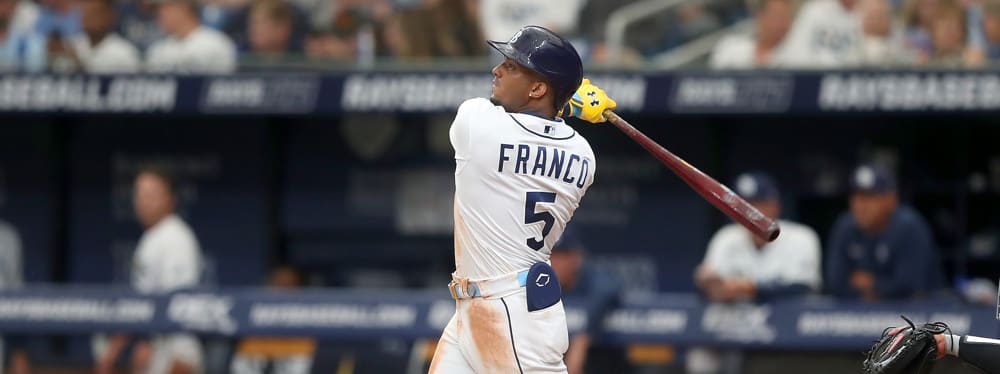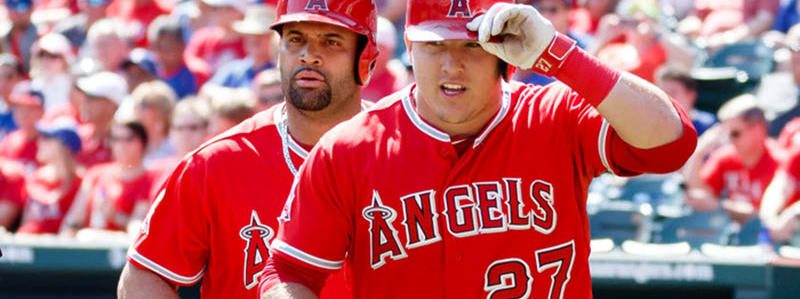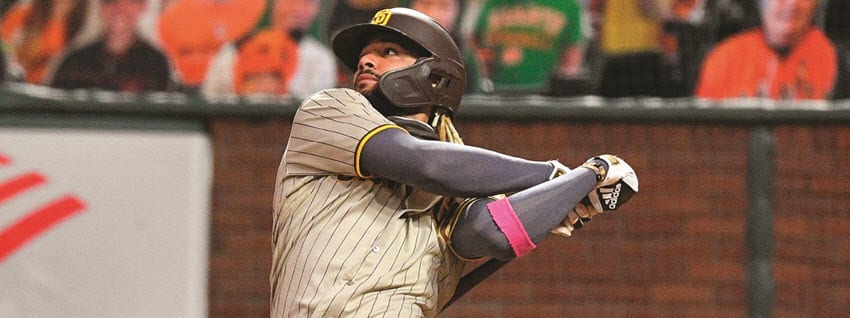Recent RotoWire Articles Featuring Hanley Ramirez
See More
After playing just 44 generally unsuccessful games in 2018, it wouldn't have been at all surprising had Ramirez called it quits after a 14-year big-league career. He wanted to keep playing, though, and Cleveland gave him that chance, giving him the designated hitter spot on Opening Day. Unfortunately for the veteran, things didn't go any better this time around, as he played just 16 games for the team before being released with a .184/.298/.327 slash line in late April. He again failed to find a new team for the rest of the season, eventually undergoing season-ending shoulder surgery in mid-July. At the time of the surgery, he said he intended to play in 2020, though it may be hard for him to find a job. It's hard to see why a team would want a 36-year-old who's posted a wRC+ below 100 in four of his last five seasons, especially if that player can't play anywhere but first base.
If Ramirez can't make it back to the majors this season, it will mark the end to an impressive career. While 1,825 hits and 269 homers aren't Hall of Fame numbers, they are very good totals for a player who spent the bulk of his career at shortstop. He hasn't played there in four years, though, and his .254/.313/.395 line through 44 games wasn't nearly good enough for a first baseman, leading to his release from the Red Sox in late May. That release was followed by reports tying him to a drug-related federal investigation, though subsequent reports denied his involvement. Whether due to that situation or not, Ramirez failed to latch on with another organization over the rest of the campaign. He's attempting to get another big-league job this offseason, but it's not clear whether any team will have interest in a 35-year-old first baseman who hasn't posted an above-average batting line since 2016.
For the second time in three years, Ramirez graded out as a below-replacement-level real-life player (as measured by fWAR), and his fantasy utility took a hit as well in his age-33 season. His run and RBI totals fell off a cliff, which was due in large part to a shoulder issue and a .209/.317/.317 line in 161 plate appearances with runners in scoring position (down from .294/.404/.551 in 2016). His overall OBP fell 41 points and his wOBA fell 49 points, but the Statcast data points to a significant amount of bad luck (.262 xBA, .351 xwOBA, .479 xSLG). While Ramirez posted a dismal .179/.293/.387 line against lefties, it was a relatively small sample (106 at-bats). His career track record against southpaws is excellent (.295/.376/.521). He's UTIL-only now in most formats and will almost certainly fall short of the 497 plate appearances he needs for his 2019 option to vest, but Ramirez has bounce-back potential in terms of rate production, assuming he can avoid the nagging injuries.
Ramirez returned to form in 2016, moving to first base, the veteran batted .288 in the first half of the season, although he only hit eight home runs and slugged .435. He turned the page in the second half, though, belting 22 home runs and driving in 63 runs. His second-half surge brought his slugging percentage up to .505, his best mark since his injury-shortened 2013 campaign with the Dodgers. He only qualifies at first base heading into 2017, and while there had been speculation that he would take over for David Ortiz as the team's everyday DH this season, a slew of offseason moves now make it seem possible that Ramirez will start at first base against lefties, spelling Mitch Moreland. This would allow Ramirez to retain first base eligibility in most formats, which would be important for his value in keeper leagues. He is a good bet to offer four-category production with a handful of steals thrown in, hitting in the middle of a loaded Red Sox lineup.
While several personnel decisions contributed to Boston firing general manager Ben Cherington, Ramirez was the primary reason for the GM's dismissal. Cherington signed Ramirez to a four-year, $88 million deal with the idea that the life-long infielder would play left field at Fenway Park. Ramirez was part of a solution to replace the lost offense in 2014. And it looked good early when Ramirez hit 10 homers with 22 RBI and a .999 OPS in April. An early-May shoulder injury was the season's turning point. His power dropped and when he wasn't hitting, his defensive follies in the outfield became more apparent. His -17.8 UZR (FanGraphs) was by far the league worst in left field. The shoulder injury came back in August and he didn't play the remainder of the season. If the Red Sox can't find someone to take on Ramirez's contract, they'll work him out at first base during training camp and hope to stash him there until 2017.
A laundry list of injuries -- shoulder, calf, oblique, and hand -- limited Ramirez to 128 games in 2014, and it's fair to wonder just how many of his 512 plate appearances came at a level close to 100 percent health. With free agency on the horizon, Ramirez had every incentive to try and tough it out and prove that his injury-riddled seasons in 2011 and 2013 were truly behind him. Instead, his defense at shortstop regressed further, and he slugged just .411 in the second half. Overall, his performance at the plate was acceptable, as he led qualified shortstops in OPS (.817) and wOBA (.362) while providing double-digit home runs (13) and steals (14) for the ninth consecutive season. Ramirez has struggled to stay healthy over the better part of the past four seasons, but he'll remain shortstop eligible despite the expected move to left field with Boston, and there is some justifiable optimism about his power returning as he just one year removed from a career-high .293 ISO in 2013.
A variety of injuries limited Ramirez to 86 games in 2013, but when healthy, he performed like an MVP candidate. Ramirez batted .345/.402/.638 with 20 home runs and 10 stolen bases in just 304 at-bats. This came after he hit just .243 and .257 the preceding two seasons, so the bat is back, but will his health be there in 2014? If you buy into the whole "guys perform better in contract years," Ramirez is your guy in 2014, as he's scheduled to hit free agency after the season. At the very least, the lineup around him in Los Angeles provides an excellent supporting cast to help him pile up counting stats.
Once a guy who appeared to be headed toward a Cooperstown-worthy career, Ramirez has seen his performance drop off dramatically the past two seasons. Though he improved somewhat after being traded to the Dodgers, an overall .257/.322/.437 slash line is uninspiring. His fantasy numbers were a bit better, as Ramirez managed to reach the 20/20 mark with 92 RBI. Given he's still just 29, better power numbers and 100-plus RBI are not out of the question in 2013, particularly given the improved lineup around him.
The bottom fell out for Ramirez last year, as he was ice cold coming out of spring training and then got beset by a series of injuries to his foot, back and finally his left shoulder that limited him to just 92 games. He was showing signs of regaining his swagger at the plate before the shoulder injury ended his season though and offseason surgery should prevent any future issues with the joint, although it's worth noting the same thing was said after his 2008 surgery on the same shoulder. The question now is where he will play. The Marlins want him to slide over to third base in the wake of the Jose Reyes signing, but Ramirez at times has appeared a bit, shall we say, grumpy at the thought and trade rumors have sprouted up as a result. The odds of him actually being dealt are slim (with $47 million and three years remaining, his contract is still very reasonable given his possible production, and coming off the season he had his value has never been lower) but if he's disgruntled to start the season another limp April could be in the offing. The upside is still there though, especially given the improvements in the lineup around him, and despite last year's disaster you're not likely to get Ramirez at much of a discount. Frankly we think he's too talented and too proud not to rebound, health permitting. If he slides at all at your draft table, pounce.
After three all-world seasons, Ramirez stumbled last year and put up his worst offensive numbers since he was a rookie. It's a testament to his talent that a .300 average and 20 HR/30 SB would be considered a crushing disappointment, but nagging injuries dragged him down and an early-season run-in with manager Edwin Rodriguez didn't help put to rest questions about his work ethic and commitment. In real terms, his "poor" numbers were a result of a big spike in his groundball percentage at the expense of flyballs and line drives, and assuming better health and/or a tweak in his stance to address that problem there's no reason to think Ramirez won't regain his place among the fantasy elite.
Once again Ramirez had a great season that still seemed somehow faintly disappointing. For the first time in his major league career he failed to steal 30 bases, he went back to being a 25-homer, 40-double player instead of a 30-homer, 30-double one, and he gave back the extra walks he drew in 2008. In exchange though he led the NL in batting average, setting a new franchise record in the process, posted his first 100-RBI season thanks to a shift down to the No. 3 spot in the batting order, and finished second in MVP voting to Albert Pujols. The declining speed is perhaps inevitable as Ramirez gets older and continues to fill out, but at 26 he's hardly an old man just yet, and there's no reason to think his development has completely plateaued. He's one of the truly elite players in fantasy baseball.
Superficially it might appear as though Ramirez took a step back at the plate in 2008. He traded a 25/50 season for a 30/30 one (a swap no self-respecting fantasy owner would make) and lost some batting average to boot. The huge spike in his walk rate can't just be written off as a product of a lack of lineup protection though, and provides some optimism that despite his tremendous production the last two seasons, the best may be yet to come. Ramirez is already in the discussion when it comes to naming the most valuable assets in the game today, but if those walks truly are a harbinger he could move to the head of the list by the end of 2009.
Ramirez struggled in the field in 2007, but his huge offensive season far overshadowed that regression in his game. He fell just one home run short of becoming the youngest member of the 30-HR/50-SB club (Eric Davis was 25 and Barry Bonds 26 when they accomplished the feat, while Ramirez didn't turn 24 until this offseason) and hit .332 while doing so. He also put up those numbers despite separating his left shoulder in July on a swing and a miss, the third time in a year and a half he's had problems with that shoulder. Ramirez had offseason surgery to repair his labrum, and there has to be at least a little concern his shoulder problems could become chronic, but as a true five category shortstop the "reward" end of that risk/reward scenario is far too enticing to pass up. A move down to the third spot in the order in the wake of the Miguel Cabrera trade could also reduce his steal attempts and runs while boosting his RBI, but he's an elite talent no matter where he hits.
Of all the Marlins' rookie surprises in 2006, none were more shocking than Ramirez. The team itself had so little confidence that he was ready for an every-day job in the majors they brought in Pokey Reese as an insurance policy in the spring, only to see Reese abruptly leave camp and retire before Opening Day. Maybe Reese realized how unnecessary his presence in a Florida uniform would be. Ramirez hit for a better average, showed more power, and drew more walks than his minor league profile indicated were within the realm of possibility, while stealing 51 bases (at a productive percentage) and playing at times somewhat erratic but at times spectacular defense. His 2005 regression at Double-A is still fresh enough to be a warning sign, but then again Ramirez's numbers as a 22-year-old rookie look very good next to Derek Jeter's first full big league season at a similar age. Given his tools and explosive start, Ramirez could end up being the best NL fantasy shortstop since Barry Larkin in his prime.
Ramirez got into a couple of games for Boston in September after an unspectacular season at Double-A Portland. He's still young so there's time for him to find his power and hit consistently. He already has the speed and defensive tools needed, so it's a matter of the offense catching up. After his trade to the Marlins in the Josh Beckett deal, he could win the starting shorstop job this spring.
Ramirez retained his status as the organization's top prospect after showing improved maturity in 2004. He has yet to show the power potential that many have predicted, but that could come. Whether the power comes this season or not, he's got a top-notch glove and is an exceptional athlete, who may be asked to play another position. Boston’s signing of Edgar Renteria obviously is of great impact on Ramirez’ immediate future. There was speculation he would be the Red Sox’ starting shortstop in 2006. We would not be surprised to see the major league club trade him in the pursuit of starting pitching to replace Pedro Martinez.
Ramirez is one of the top prospects in the Red Sox organization. He had some disciplinary problems last season and his average dropped, but he still was among the Sally League leaders in runs scored and stolen bases. Ramirez, 19, should get his promotion to High-A this season and could move up if the club is convinced he has matured.
Signed out of the Dominican Republic in 2000, the 19-year old has dominated the Rookie levels in his two years as a professional. In 2002 he made stops at Rookie Ball and the short season Penn League, showing power, speed, and great strike zone judgement for one so young. A legitimate five-tool prospect, the only thing that might derail a meteoric rise is attitude. It’s been suggested he might be somewhat immature. The comparisons to Arod, Nomar, and Soriano are inevitable but he’s years away from living up to that hype, if ever.
The 2003 season should begin with him at Low Class-A and a mid-season promotion is a strong possibility. He’s probably still a couple of year’s away from a look at the majors.













